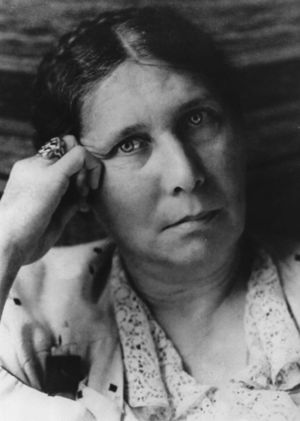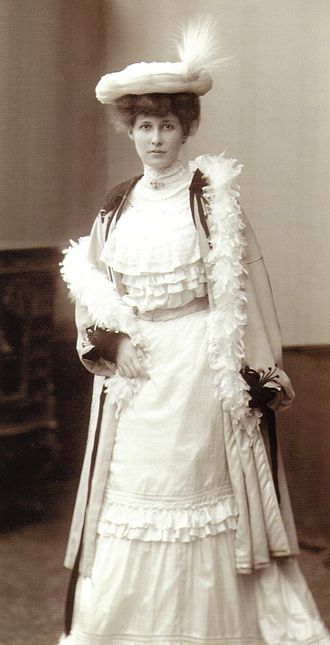Ita Wegman

Maria Ita Wegman (* 22 February 1876 in Karawang, West Java, Indonesia; † 4 March 1943 in Arlesheim, Switzerland), who was Dutch by descent and was always called Ita Wegman throughout her life, was the founder of anthroposophically extended medicine together with Rudolf Steiner.
Wegman studied medicine at Rudolf Steiner's suggestion only when she was already over thirty years old. As early as 1921, the socially committed doctor founded the world's first and, until the 1960s, only anthroposophical clinic in Arlesheim (Switzerland). Today it is named after her, just like the classical rhythmic massage according to Ita Wegman, which was developed into an independent form of therapy in anthroposophical medicine.
Wegman developed new special forms of care, special rubs and wraps.
She also cared for Rudolf Steiner in the last months of his life and until his death.
Life


Ita Wegman was born in Indonesia in 1876, the second of six children in a Dutch colonial family. Her father Hendrik was then the administrator of the sugar factory "Parakanteroes" ("The Straight Way") in the Karawang residence in the west of Java. Her mother Henriette was a fine-boned but powerful person who was also able to withstand the hardships of life. Soon her father was transferred to the east of Java to manage the "Gending" sugar factory near Probolinggo. Ita Wegman attended primary school in the town, about an hour's journey away by coach, from 1882. She proved to be an excellent pupil and was always ambitious to be the best in her class. After finishing primary school, she received private lessons together with her younger sister Charlien.
In 1891, Ita and her sister were sent to Arnhem for further schooling. In 1894 she returned to Java. On the return journey she met a young officer and became engaged to him, but he soon died of tuberculous pneumonia. The search for spiritual internalisation begins. She takes piano and singing lessons with Mrs Henny Steinbuch-Bastiaans, with whom she becomes friends. Together with her she begins to study theosophy from about 1896, as it was then disseminated in books by the Adyar Theosophical Society.
In 1899 the family returned to Holland due to a serious illness of the father. Ita Wegman trained in healing gymnastics and massage in Holland, partly in Germany.
In 1902, at the age of 26, Ita Wegman met Rudolf Steiner for the first time in Berlin and joined the German Section of the Theosophical Society (DSdTG), an offshoot of the Adyar-TG. The turn of the year 1912/13 brought the separation of the DSdTG from the Adyar-TG and the founding of the Anthroposophical Society. Wegman followed Steiner's direction and became an anthroposophist.
In 1906 she began studying medicine at the University of Zurich, where women also had access to the medical faculty. She finished her studies in 1911 with a medical diploma and as a specialist in gynaecology. She then worked for several years as an assistant doctor in various hospitals, including Winterthur and Liestal. In 1912 she opened her own practice in Zurich with an attached small infirmary and the possibility of physical therapy. From here she went to Dornach as often as she could on weekends to listen to Rudolf Steiner's lectures.
In 1917, in her first own practice, she produced a remedy for cancer from mistletoe, with Rudolf Steiner's help. The so-called Iscar later developed into the oldest mistletoe preparation, Iscador. In 1919 she ran a joint practice with two other female doctors in Zurich.
In 1920 she bought the property Hirsland 198 in Arlesheim and in 1921 opened her private clinic Klinisch-Therapeutisches Institut (today "Ita Wegman Clinic") there. It was here that the still young Anthroposophical Medicine was first developed and practically applied in close collaboration with R. Steiner.
In 1922 Wegman founded the curative home Haus Sonnenhof for children in need of spiritual care, also in Arlesheim. In the same year, with her decisive participation, the International Laboratories & Clinical Therapeutic Institute Arlesheim AG (today's Weleda AG) was founded with the participation of Futurum AG - economic society for the promotion of economic and spiritual values (Dornach).
After the fire of the first Goetheanum on New Year's Eve 1922/23, Ita Wegman became the most important collaborator of R. Steiner, who probably also saw fateful ("karmic") connections in the collaboration with the doctor. The following year Rudolf Steiner appointed her to the "esoteric" founding board of the General Anthroposophical Society. Together with him, after the founding conference of the AAG (the so-called "Christmas Conference"), she led the "First Class" of the likewise newly founded School of Spiritual Science at the Goetheanum.
In 1925, together with Rudolf Steiner, she published the basic medical anthroposophical work «Grundlegendes zur Erweiterung der Heilkunst nach geisteswissenschaftlichen Erkenntnissen». Ita Wegman nursed R. Steiner from September 1924 during his illness until his death in March 1925.
Wegman also became co-founder and head of the Medical Section of the School of Spiritual Science at the Goetheanum in Dornach. In this capacity she initiated and accompanied the founding of numerous medical and curative education institutions worldwide. In the years following Steiner's death, numerous conflicts arose between the members of the Executive Council, namely Marie Steiner and Ita Wegman, over the continuation of anthroposophical work in the AAG, which led in 1935 to Ita Wegman and Elisabeth Vreede being recalled from their positions on the Executive Council and their supporters being expelled from the Society by the General Assembly. Even before this happened, Ita Wegman wrote to Maria Röschl, dated 22 February 1935:
„All the old forms, including the very last form for Anthroposophy, have been thoroughly broken, and it now seems to me as if one no longer has to look for a form for the life of Anthroposophy, but that every human being is himself the form with which Anthroposophy wants to unite. Where this has happened, people will find each other and unite to become a member of the true Spiritual Society. Society is no longer necessary because Anthroposophy is already on Earth. What matters now is the individual human being, and they must then form together out of their development a higher association which has its roots in the spiritual world. Every individualistic development is hereby preserved, every freedom of the individual human being and out of the insight of the individual human being he feels connected with this spiritual association or Michael School. This is how it sounded to me in my inner being. What matters is my own standing within this impulse. The others will take care of themselves.“ (Lit.: quoted from Kiersch, p. 312)
The exclusion was not lifted as unjustified until 1948, five years after Wegman's death.
In 1936 a dependence of her clinic was founded in Ascona (Switzerland), where Ita Wegman spent most of her time in her last years.
In 1943 Ita Wegman died in Arlesheim at the age of 67. Her urn was buried in a chapel in Ascona designed by the artist and art therapist Liane Collot d'Herbois, a close friend of Wegman.
Literature
- Bücher
- Johan Zeylmans van Emmichoven: Wer war Ita Wegman - Eine Dokumentation. 4 Bde. Erstausgabe: Heidelberg, 1990-1992 (rund 1.200 Seiten). Verlag am Goetheanum, Dornach.
- Bd. 1: 1876 bis 1925. 2004. (unveränd. Aufl.) ISBN 3723510752
- Bd. 2: 1925 bis 1943. 1992. (2. neubearb. Aufl.) ISBN 3723510760
- Bd. 3: Kämpfe und Konflikte 1924 bis 1943. 1992. (2. neubearb. Aufl.) ISBN 3723510779
- Bd. 4: Die Erkraftung des Herzens: Eine Mysterienschulung der Gegenwart. 2015. (2. Aufl.) ISBN 3905919133
- Ita-Wegman-Fonds für Soziale und Therapeutische Hilfstätigkeiten (Hg.): Ita Wegmans Lebenswirken aus heutiger Sicht - Eine Festschrift zu ihrem 100. Geburtstage. Beiträge ihrer Freunde. Natura-Verlag. Arlesheim. 1980. ISBN 3-85817-064-X (2. Aufl.)
- Wolfgang Weirauch, Emanuel Zeylmans: Ita Wegman und die Anthroposophie - Ein Gespräch mit Emanuel Zeylmans. Flensburger Hefte, Sonderheft Nr. 17. Flensburger-Hefte-Verlag. Flensburg. 1996. ISBN 3-926841-77-X, Inhaltsangabe: PDF
- M. van Deventer, E. Kirchner, A. Leroi, Hilma Walter: Erinnerungen an Ita Wegman. Klinisch-Therapeutisches Institut Arlesheim. Arlesheim. 1945. - Natura-Verlag. Arlesheim. 1987. ISBN 3-85817-063-1 (3. unveränd. Auflage)
- Willem F. Daems: Ita Wegman - Zürcher Zeit 1906-1920. Erste ärztliche Krebsbehandlung mit der Mistel. (Weleda-Schriftenreihe, Bd. 17) Verlag am Goetheanum. Dornach. 1986. ISBN 3-7235-0440-X
- Peter Selg: Geistiger Widerstand und Überwindung - Ita Wegman 1933-1935. (Schriftenreihe des Ita-Wegman-Archivs, Bd. 6) Natura-Verlag im Verlag am Goetheanum. Dornach. 2005. ISBN 3-7235-1229-1
- Peter Selg: Die letzten drei Jahre - Ita Wegman in Ascona 1940-1943. Natura-Verlag im Verlag am Goetheanum. Dornach. 2004. ISBN 3-7235-1205-4
- Peter Selg: „Ich bin für Fortschreiten“ - Ita Wegman und die Medizinische Sektion. Natura-Verlag im Verlag am Goetheanum. Dornach. 2002. ISBN 3-7235-1140-6
- Peter Selg: Der Engel über dem Lauenstein - Siegfried Pickert, Ita Wegman und die Heilpädagogik. 2004. Natura-Verlag im Verlag am Goetheanum. Dornach. ISBN 3-7235-1209-7
- Peter Selg: Sterben, Tod und geistiges Leben - Die Kondolenzbriefe Ita Wegmans und das Todesverständnis der anthroposophischen Geisteswissenschaft. (Schriftenreihe des Ita-Wegman-Archivs, Bd. 5) Natura-Verlag im Verlag am Goetheanum. Dornach. 2005. ISBN 3-7235-1228-3
- Peter Selg: Das soziale Wirken Ita Wegmans im 20. Jahrhundert - Vortrag am 10.6.2005 in Schloss Hamborn. In Peter Selg und Matthias Wildermuth, Zwei Vorträge / herausgegeben von Edition Freie Rede Schloss Hamborn, Borchen - Juni 2006
- Johannes Kiersch: Steiners individualisierte Esoterik einst und jetzt. Zur Entwicklung der Freien Hochschule für Geisteswissenschaft, Verlag am Goetheanum, Dornach 2012. ISBN 978-3-7235-1464-1
- Zeitschriften
- Quinte. Fünf Beiträge zu Gesundheit und Qualität. (Schwerpunktthema: Dr. Ita Wegman) Natura-Verlag. Arlesheim. Heft 10/Herbst 2004. ISSN 1424-9146
- Mitteilungen aus dem Anthroposophischen Leben in der Schweiz. Sonderheft: Besinnung auf Maria Ita Wegman. (Die treue Mitarbeiterin Rudolf Steiners - Die geistige Kämpferin für eine michaelische Zukunft - Die Mitbegründerin des anthroposophisch erweiterten medizinischen Impulses). 1997. 108 S.
| This article is partly based on the article Ita Wegman from the free encyclopedia de.wikipedia and is licensed under Creative Commons Attribution/Share Alike. Wikipedia has a list of authors available. |
